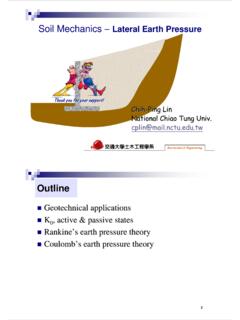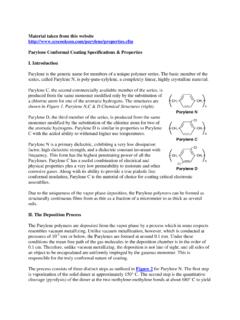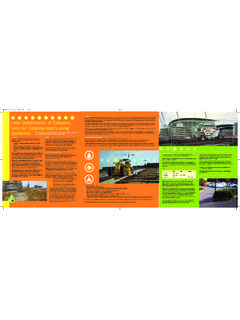Transcription of Soil Compaction - National Chiao Tung University
1 soil CompactionChihChih--Ping LinPing LinNational National Mechanics ImprovementSoil of CompactionTheory of and Structure of Compacted FineProperties and Structure of Compacted Fine--Grained SoilsGrained Compaction Equipment and ProceduresField Compaction Equipment and Compaction Control and SpecificationsField Compaction Control and SpecificationsMethods for soil ImprovementGroundReinforcementGroundImpr ovementGroundTreatment Stone Columns soil Nails Deep soil Nailing Micropiles (Mini-piles) Jet Grouting Ground Anchors Geosynthetics Fiber Reinforcement Lime Columns Vibro-Concrete Column Mechanically Stabilized Earth Biotechnical Deep Dynamic Compaction Drainage/Surcharge Electro-osmosis Compaction grouting Blasting Surface Compaction soil Cement Lime Admixtures Flyash Dewatering Heating/Freezing VitrificationCompactionShaefer, 1997 soil ImprovementMethods for soil Improvement- Jet GroutingCourtesy of Menard-soltraitementSoil ImprovementMethods for soil Improvement- soil NailingCourtesy of Atlas Copco Rock Drilling EquipmentSoil ImprovementElephant and CompactionHeavy WeightQuestion?
2 The Compaction result is not good. Why?He He! I m ImprovementCompaction and ObjectivesCompactionCompaction Many types of earth construction, such as dams, retaining walls,Many types of earth construction, such as dams, retaining walls,highways, highways, and airport, require manand airport, require man--placed soil , or fill. To compact a soil , that is, to place placed soil , or fill. To compact a soil , that is, to place it in a dense in a dense state. The dense state is achieved through the reduction of the air voiThe dense state is achieved through the reduction of the air voids in the soil , ds in the soil , with little or no reduction in the water content.
3 This process mwith little or no reduction in the water content. This process must not be ust not be confused with consolidation, in which water is squeezed out undeconfused with consolidation, in which water is squeezed out under the action r the action of a continuous static a continuous static :Objectives: Decrease future settlementsDecrease future settlements Increase shear strengthIncrease shear strength Decrease permeabilityDecrease permeability(From Lambe, 1991; Head, 1992)CompactionGeneral Compaction MethodsCoarse-grained soilsFine-grained soils Hand-operated vibration plates Motorized vibratory rollers Rubber-tired equipment Free-falling weight.
4 Dynamic Compaction (low frequency vibration, 4~10 Hz) Falling weight and hammers Kneading compactors Static loading and press Hand-operated tampers Sheepsfoot rollers Rubber-tired rollersLaboratoryFieldVibration Vibrating hammer (BS)(Holtz and Kovacs, 1981; Head, 1992)KneadingCompactionLaboratory CompactionOriginOriginThe fundamentals of Compaction of fineThe fundamentals of Compaction of fine--grained soils are relatively new. grained soils are relatively new. Proctor in the early Proctor in the early 1930 s was building dams for the old Bureau of s was building dams for the old Bureau of Waterworks and Supply in Los Angeles, and he developed the princWaterworks and Supply in Los Angeles, and he developed the principles iples of Compaction in a series of articles in Engineering Newsof Compaction in a series of articles in Engineering News--Record.
5 In his Record. In his honor, the standard laboratory Compaction test which he developehonor, the standard laboratory Compaction test which he developed is d is commonly called the commonly called the proctor testproctor purpose of a laboratory Compaction test is to determine the The purpose of a laboratory Compaction test is to determine the proper proper amount of mixing wateramount of mixing waterto use when compacting the soil in the field and to use when compacting the soil in the field and the the resulting degree of densenessresulting degree of densenesswhich can be expected from Compaction which can be expected from Compaction at this optimum waterat this optimum waterImpact compactionImpact compactionThe
6 Proctor test is an The proctor test is an impact compactionimpact Compaction . A hammer is dropped several . A hammer is dropped several times on a soil sample in a mold. The mass of the hammer, heighttimes on a soil sample in a mold. The mass of the hammer, heightof drop, of drop, number of drops, number of layers of soil , and the volume of thenumber of drops, number of layers of soil , and the volume of themold are mold are of CompactionTest EquipmentStandard Proctor test equipment Das, 1998 Theory of CompactionSummary of Standard ProctorCompaction Test Specifications (ASTM D-698, AASHTO)Das, 1998 Theory of CompactionStandard Proctor Compaction TestModified Proctor Compaction TestSummary of Modified ProctorCompaction Test Specifications (ASTM D-698, AASHTO)Das, 1998 Theory of CompactionComparison-SummaryStandard Proctor Test12 in height of lb hammer25 blows/layer3 layersMold size.
7 1/30 ft3 Energy 12,375 ft lb/ft3 Modified Proctor Test18 in height of drop10 lb hammer25 blows/layer5 layersMold size: 1/30 ft3 Energy 56,250 ft lb/ft3 Higher compacting energyTheory of CompactionComparison-Why? In the early days of Compaction , because construction equipment In the early days of Compaction , because construction equipment was small was small and gave relatively low Compaction densities, a laboratory methoand gave relatively low Compaction densities, a laboratory method that used d that used a small amount of compacting energy was required. As constructioa small amount of compacting energy was required. As construction n equipment and procedures were developed which gave higher densitequipment and procedures were developed which gave higher densities, it ies, it became necessary to increase the amount of compacting energy in became necessary to increase the amount of compacting energy in the the laboratory test.
8 The modified test was developed during World War II by the The modified test was developed during World War II by the Army Army Corps of Engineering to better represent the Compaction requiredCorps of Engineering to better represent the Compaction requiredfor airfield for airfield to support heavy aircraft. The point is that increasing the to support heavy aircraft. The point is that increasing the compactivecompactiveeffort effort tends to increase the maximum dry density, as expected, but alsotends to increase the maximum dry density, as expected, but alsodecrease decrease the optimum water optimum water content.
9 (Holtz and Kovacs, 1981; Lambe, 1991)Theory of CompactionVariables of CompactionProctor established that Compaction is a function of four variables:(1)Dry density ( d) or dry unit weight d.(2)Water content w(3)Compactive effort (energy E)(4) soil type (gradation, presence of clay minerals, etc.))ft/lbft375,12( )layer/blows25)(layers3)( )( ( = =Volume of moldNumber of blows per layerNumber of layersWeight of hammerHeight of drop of hammer E =For standard Proctor testTheory of CompactionProcedures and Results ProceduresProcedures(1)(1)Several samples of the same soil , but at different water contentSeveral samples of the same soil , but at different water contents, are s, are compacted according to the Compaction test according to the Compaction test specifications.
10 (2)(2)The total or wet density and the actual water content of each The total or wet density and the actual water content of each compacted sample are sample are measured.(3)(3)Plot the dry densities Plot the dry densities ddversus water contents w for each compacted versus water contents w for each compacted sample. The curve is called as a sample. The curve is called as a Compaction curvecompaction ,VMdtt+ = = Derive dfrom the known and wThe first four blowsThe successive blowsTheory of CompactionProcedures and Results (Cont.)ResultsZero air voidWater content w (%)Dry density d(Mg/m3)Dry density d(lb/ft3)Line of optimumsModified ProctorStandard ProctorPeak pointLine of optimumZero air voidHoltz and Kovacs, 1981 d maxwoptTheory of CompactionProcedures and Results (Cont.)






![ABSTRACT arXiv:1409.1556v6 [cs.CV] 10 Apr 2015](/cache/preview/4/e/0/e/4/4/2/c/thumb-4e0e442c20fc4f8e108fa20a1095af07.jpg)

